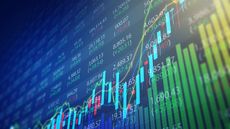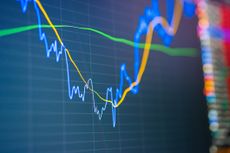Why You Should Buy Stocks Today
Even if you buy at the market’s highest level of the year, a recent study finds that it makes little difference over the long term.

Today’s stock market exhibits plenty of worrisome signs. Stocks of small companies have been sinking, which is often a bad sign for the broader market. Economic growth remains sluggish years after the worst recession since the Great Depression. Vladimir Putin’s mischief ultimately threatens the crucial flow of natural gas from Russia to Western Europe.
Why buy now, when the leading market indexes are at record highs? Because a review of recent history shows that the date you pick to invest doesn’t matter that much, even if you invest at the market’s highest level of the year.
Sound crazy? Dan Wiener, editor of The Independent Adviser for Vanguard Investors, compared the records of two hypothetical investors over the past 30 years. Each started by investing $1,000 in Standard & Poor’s 500-stock index at the end of 1983. (Of course, you can’t buy an index, but you can invest in a low-cost index fund.) Over the subsequent 30 years, each investor put $1,000 annually into the S&P 500. But investor one bought on the last trading day of the year, while investor two bought at the S&P’s highest point each year. In other words, investor two bought on the worst possible day each year.

Sign up for Kiplinger’s Free E-Newsletters
Profit and prosper with the best of expert advice on investing, taxes, retirement, personal finance and more - straight to your e-mail.
Profit and prosper with the best of expert advice - straight to your e-mail.
Here’s the surprise: At the end of 30 years, investor one had achieved an annualized return of 9.9%, while investor two earned an annualized return of 9.5%. The difference in returns was just 0.4 percentage point per year, on average.
In dollar terms, investor one’s total contributions of $31,000 grew to $177,176, while the additions of the investor with extremely poor timing grew to $169,153. The difference is $8,023. If you’re saving for retirement, you’d hope to invest a lot more than $31,000 over three decades, which would result in a far greater dollar gap.
The difference between the two approaches is significant. But it’s not nearly as much as I would have expected, and it puts some perspective into all the agonizing many of us go through before we put new money to work in stocks.
Of course, if you could accurately time the stock market, you could enrich yourself enormously. Over the past five years through April 30, the S&P 500 returned a sizzling 19.1% annualized. But from December 31, 1999, through April 30, the index returned only 3.7% annualized. So clever market timing would have done far better than buying and holding through this period, which included two vicious bear markets. In the 2000-02 bear market, the S&P plunged 47%, and in 2007-09, it did even worse, sinking 55% (both figures include dividends). Since 1926, large-company stocks have returned an annualized 10.1%, according to Ibbotson Associates—almost three times the return so far this century.
Wiener’s study provides evidence of the merits of dollar-cost averaging—that is, investing a fixed amount at regular intervals, in this case once a year. Indeed, if you had invested $1,000 annually in the S&P on the last day of the year from 1999 through 2013, you would have earned a 7.0% annualized return by April 30—almost double what a one-time, lump sum investment at the start of the century would have produced.
The lesson is clear: Dollar-cost averaging works wonders in volatile markets. But the bigger lesson is even clearer: If you plan to buy stocks this year, go ahead and invest now—even if you think the market may be at its yearly high.
Steve Goldberg is an investment adviser in the Washington, D.C., area.

To continue reading this article
please register for free
This is different from signing in to your print subscription
Why am I seeing this? Find out more here

-
 Is a Phased Retirement Right for You?
Is a Phased Retirement Right for You?Want to keep working, just not as hard? A phased retirement may just be the answer.
By Kimberly Lankford Published
-
 Four Tips to Make Your Sales Presentation a Winner
Four Tips to Make Your Sales Presentation a WinnerBeing prepared and not being boring can go a long way toward persuading a potential customer to buy into what you’re offering.
By H. Dennis Beaver, Esq. Published
-
 Stock Market Today: Markets Rebound Ahead of Big Week for Earnings
Stock Market Today: Markets Rebound Ahead of Big Week for EarningsEquities rallied on easing geopolitical tensions, upcoming quarterly results.
By Dan Burrows Published
-
 Stock Market Today: Nasdaq Spirals as Netflix Nosedives
Stock Market Today: Nasdaq Spirals as Netflix NosedivesA big earnings boom for credit card giant American Express helped the Dow notch another win.
By Karee Venema Published
-
 Stock Market Today: S&P 500, Nasdaq Extend Losing Streaks
Stock Market Today: S&P 500, Nasdaq Extend Losing StreaksThe two indexes have closed lower for five straight sessions.
By Karee Venema Published
-
 Stock Market Today: Dow Slips After Travelers' Earnings Miss
Stock Market Today: Dow Slips After Travelers' Earnings MissThe property and casualty insurer posted a bottom-line miss as catastrophe losses spiked.
By Karee Venema Published
-
 Stock Market Today: Stocks Stabilize After Powell's Rate-Cut Warning
Stock Market Today: Stocks Stabilize After Powell's Rate-Cut WarningThe main indexes temporarily tumbled after Fed Chair Powell said interest rates could stay higher for longer.
By Karee Venema Published
-
 Stock Market Today: Stocks Reverse Lower as Treasury Yields Spike
Stock Market Today: Stocks Reverse Lower as Treasury Yields SpikeA good-news-is-bad-news retail sales report lowered rate-cut expectations and caused government bond yields to surge.
By Karee Venema Last updated
-
 Stock Market Today: Nasdaq Leads as Magnificent 7 Stocks Rise
Stock Market Today: Nasdaq Leads as Magnificent 7 Stocks RiseStrength in several mega-cap tech and communication services stocks kept the main indexes higher Thursday.
By Karee Venema Published
-
 Stock Market Today: Stocks Tumble After a Hot Inflation Print
Stock Market Today: Stocks Tumble After a Hot Inflation PrintEquities retreated after inflation data called the Fed's rate-cut plans into question.
By Dan Burrows Published